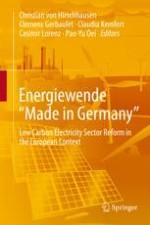Long-term scenarios of the low-carbon energy transformation in Europe are quite diverse. In this chapter, we provide a detailed discussion of scenarios leading to a far-reaching decarbonization of the European energy system to 2050. We use an updated version of the Global Energy System Model (GENeSYS-MOD), developed by our group to study various low-carbon transformation processes at global, continental, or national level. The modeling results suggest that a largely renewables-based energy mix is the lowest cost solution to the decarbonization challenge, and that the distribution of the carbon budget has a strong impact on the results. Our model calculations thus confirm bottom-up results obtained for the electricity sector, in Chap.
10, suggesting that the solution to the carbon challenge is the increased use of renewable energy sources, mainly solar and wind. Section
13.2 provides a non-technical description of the model, the Global Energy System Model (GENeSYS-MOD); it is an energy system model developed recently for scenario analysis, providing a high level of technical detail, and the integrated coverage of all sectors and fuels. Section
13.3 presents different GHG emissions pathways, related to a 1.5° increase of the global mean temperature, a 2° increase, and a business-as-usual (BAU) case with a much larger emission budget. For each scenario, we distributed the emission budget to countries according to different criteria, i.e. free distribution, share of European GDP, share of current emissions, or share of population. Section
13.4 presents model results, suggesting that renewable technologies gradually replace fossil-fuel generation, starting in the power sector: By 2040, almost all electricity generation is provided by a combination of PV, wind, and hydropower, using significant amounts of storage. The pathways for transportation and heat are more diverse, but they follow a similar general trend. The commitment for a 2 °C target only comes with a cost increase of about 1–2% (dependent on the emission share) compared to a business-as-usual-pathway, while yielding reduced emissions of about 25%. The different regions and demand sectors each experience different decarbonization pathways, depending on their potentials, political settings, and technology options. Section
13.5 concludes that with already known technologies, even ambitions climate targets can be met in Europe, at moderate costs, as long as strict carbon constraints are applied.
